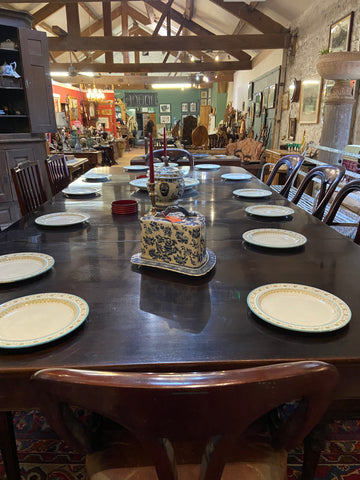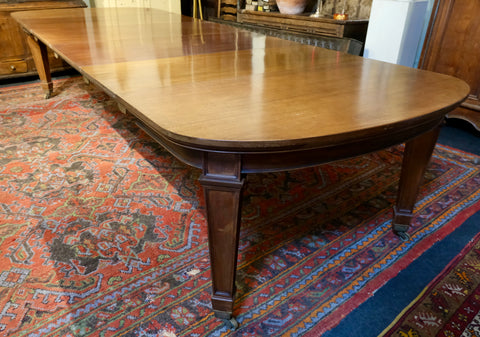All Things Gillow, Craftsmanship, Style & Substance
There are few furniture makers in the north of England that are as well-known as the Gillow family, perhaps not as highly thought of as names such as Chippendale or Sheraton, but nevertheless truly innovative furniture makers held in the highest regard.
And as such their furniture crosses our threshold fairly frequently, but that said you would be very surprised what we uncover and indeed what they as a company actually produced during their best years. Currently we have several pieces in stock in the showroom, including a Gillow style washstand, a rosewood library chair, a breakfront dwarf linen cupboard as well as an iconic Gillow extending dining table, made circa 1880-90.
Robert Gillow was born in Singleton, Lancashire, in 1704. He became an apprentice cabinet maker in Lancaster in 1718, prior to serving as a ship’s carpenter onboard a vessel bound for the Caribbean. Later returning to Lancaster in the 1720’s, becoming a freeman of the city in 1727, which allowed him to establish a business in the city as a joiner and merchant.

By 1730, Robert Gillow married Agnes Fell, whose family owned Swarthmoor Hall, and had considerable influence with close associations to the Caribbean trade. By the 1740s, Robert had upped the ante considerably chartering ships to import mahogany and export furniture, fully exploiting the connections he’d made in the Caribbean, importing rum, sugar and timber, including what is thought to be the first regular supply of mahogany into the UK through the Port of Lancaster. Cleverly directly sourcing his materials from his extensive Caribbean contacts Gillow was able to keep costs down and maximise the profits to be made, crafting simplistically styled furniture for both the domestic and export markets, enjoying something of a monopoly on the export of Windsor chairs to Jamaica.

Robert, working with his eldest son Richard, now the driving force in the family business, established an outlet on Oxford Street, in London, in 1764. Gillows’ were the only provincial furniture maker to do so, which meant they rapidly establishing links with the capital’s elite and business boomed.
Despite a couple of discernible bumps in the road in the form of the Seven Years War (1756-63) and the American War of Independence (1775-83). But despite both conflicts Gillows’ successfully established trade links with other timber producing countries in the Baltic states, where they sourced plentiful supplies of oak and pine, offsetting any potential impact and indeed ensuring that Robert was sitting pretty, as the international price of mahogany rose by around 800%, netting him a considerable fortune by his death in 1772.
New workshops were built in both Lancaster and London and furniture ordered in London was sent every week from Lancaster. Importantly, from the mid-1750s, Richard, working in Lancaster, could create fashionable new furniture based on designs sent to him by his cousin James, a designer based in London.
Creating unique pieces of furniture including the trou-madame, a female version of a billiards table, they invented the extending dining table, and a telescopic version the ‘Patent Imperial’ in 1800. They fitted secretaires with partitions and movable drawers and possibly their most renowned invention the Davenport desk, a desk produced for a captain of the same name.

Gillows’ also made numerous draw designs, occasional tables, linen presses, meat safes and even coffins! Gaining a truly international reputation as a supplier of quality furniture to the wealthy, furnishing a great number of grand country piles, before the family sold up in 1813 and joined the aristocracy themselves. It could certainly be said that at this point Gillows' have had their heyday, with discerning collectors the world over making a beeline for early pieces.
Here’s the thing, original pieces can on occasion be difficult to identify. Pieces from the 1770s, near a simple printed label. Pieces from 1780 until 1850 bear the Gillows’ Lancaster stamp it was replaced by a simple Gillow stamp, which in turn was replaced in the 1870s by a mark bearing a capital L, followed by a serial number and the Gillows’ Lancaster stamp. By the end of the 19th century came the Gillow & Co stamp, which lasted until the advent of the Waring & Gillow mark placed on a brass plate.
Sadly not all pieces were marked and that’s where things become tricky, as Gillow like all the other furniture makers of the time were very happy to copy designs for their clients. To make matters worse attribution largely went out of the window with the advent of the Waring & Gillow collaboration As a result many antique dealers, made the decision to remove any original Gillow marks and decided to attribute pieces instead to the likes of Hepplewhite, Chippendale or Sheraton, rather than having pieces attributed to what was now perceived to be an inferior maker.

Fortunately, for us, however, the Gillow archive is extensive, and detailed private records were fastidiously kept at the time, so in the main experts can easily attribute pieces using the archive and by assessing and comparing similar pieces with known provenance, so in reality it’s not as difficult to identify pieces as it might be.
Despite the sale the family firm Gillows’ or as it was to become Gillow & Co continued to flourish, winning major contracts, including one to craft Pugin’s designs for the New Palace of Westminster from 1840.
However, by the early 20th century all was not well at Gillows’ with the firm close to bankruptcy. So began a partnership with Liverpool firm Waring and a gradual downward spiral as a period considerable diversification began as the firm offered complete interior design schemes, providing everything from stained glass to wallpaper, upholstery, bespoke furniture and even interior panelling for larger homes, libraries and offices and even luxury ocean going liners and yachts, including the royal yacht Victoria and Albert and Cunard’s luxury liners the Queen Mary in 1936 and the Queen Elizabeth in 1940.
At the end of the Second Word War, the company hit hard times with the introduction of mass manufacturing processes and cheaper materials, which left the company unable to compete, and led to the Lancaster factory’s eventual closure in the 1960s.
At Yew Tree Barn we take great pride in sourcing pieces from the golden age of ‘Gillow’, principally between the late 18th to the early 19th century. To view our latest pieces please visit: https://yewtreebarn.co.uk/collections/furniture
For those with more than a passing interest in furniture made by this iconic British company they should visit, Sizergh Castle, the Judges Lodgings in Lancaster, Levans Hall and perhaps more obviously Leighton Hall, still owned by descendants of the Gillow family to this day, to view particularly fine collections of Gillow work.

Leave a comment